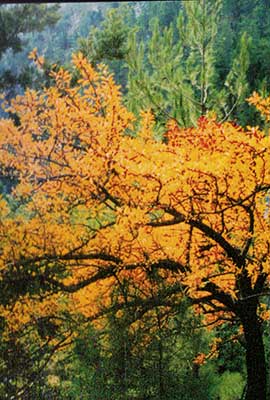Samaria is the most significant gorge of Greece. «There is only one gorge! all the others are simply canyons!», says a local Sfakian – and of course he means the Samaria Gorge, whose uniqueness is both nationally and globally recognized and it is reported in the book of the National Forest Management Agency of Samaria, Prefecture of Chania.
It is additionally emphasized that «The glamor of Samaria lies in and out of the country’s borders». It has been declared as a Biosphere Reserve from UNESCO (1981) – an attribute that is globally given for the proper management of important areas due to their significant physical and cultural identity. At the same time, it is the only region of Greece to have been awarded the Council of Europe Diploma for Protected Areas (1979).
Both of these distinctions are now given after an on-the-spot check. There is a review of the proper management of the area at regular intervals. The international distinctions of Samaria also include the title of the Biogenic Reserve (Council of Europe) of the area that is protected by the Barcelona Convention and the important area for the birds of Greece.
Therefore, so far the region is highlighted as the one with the more and the most important international distinctions and titles in our country. In Greece, Samaria gorge was declared a National Park in 1962.
Moreover, it has also been awarded with the National Nature Conservation Act (1971), it was characterized as a site of special natural beauty (1973) and a Wildlife Refuge. It is part of the European Network of Protected Areas (NATURA 2000).
In recent years, the Management Body of the Samaria National Park (2002) was established.
The Samaria Gorge is one of the canyons that crosses Lefka Ori from the north and end up in the sea, forming a special landscape in southwestern Crete. Due to the particular conditions that prevail in these gorges, particular climate and terrestrial micro environments are created. The intense surface and the continuous alterations of the landscape result in a variety of ecosystems that bring together global interest, not only by nature lovers but also by special scientists. The Samaria Gorge is a refuge for people and other organisms looking for protection in its isolation.
The wider area of Samaria is a clearly delimited and spatially determined area. One can see within this area, a diversity of landscape elements with particular characteristics of ecological and cultural value. Some of the are the following:
– The gorge
– The village at the center of the gorge with old crops
– The chapels which co-exist with ancient sanctuaries
– The castles above Samaria and at the exit of the gorge
– The ruins of the ancient city of Tara
– The special biodiversity of the gorge
The gorge itself and the wider area of Samaria as well are characterized by their strong symbolic qualities. The simple occasional «viewer» of the Samaria landscape easily perceives the wild form of the land, feels possessed by a sense of freedom and feels awe in the coexistence of man in such an inhospitable place.
The importance of Lefka Ori not only in the Greek but also in the international biodiversity is widely renowned. The flora of the region is not only characterized by a wide variety of plant species but also by the presence of many endemic species in the area. Indeed, the isolation of the gorge has contributed to the creation of these forms. The number of plant species in the gorge is not accurate because there has been no complete recording due to the specificity of the area (inaccessibility, adverse weather, etc.).
Based on the latest studies in the Lefka Ori region, there are 172 Greek endemic TAXA (TAXA: Classifier Units, namely, species and subspecies).
Out of those, 23 are found exclusively in Lefka Ori, 96 are endemic only in Crete, 12 are endemic, only in the islands of Crete and Karpathos and finally 40 out of 172 are endemic to the wider Greek area. Of these, 15 are endemic species exclusively from the specific area where they have found shelter, survived and evolved only in Samaria and they exist nowhere else in the world. Many of the endemic species are rare and are considered threatened and are therefore protected by international and national regulations.»
Source of publication 27th edition In-On

